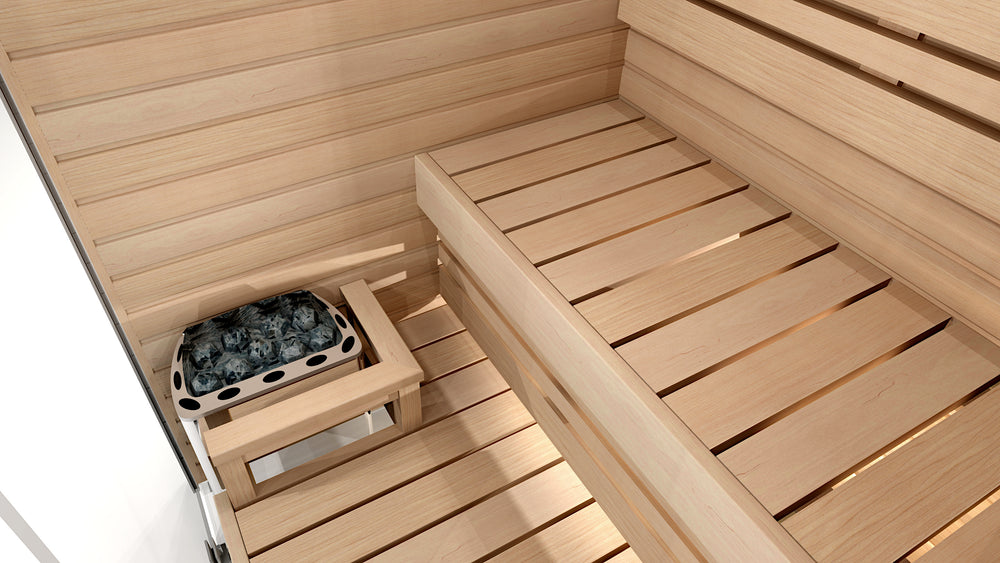Frequently Asked - Sauna Use and Maintenance
The sauna is thousands of years old, and we Finnish people continue to go to sauna regularly, and we know there are benefits to sauna since we were babies. More and more people around the world continue to discover how great the sauna is.
There have been recently some extremely well publicised scientific research about those benefits, so it's not only to our word and experience. Mainly the study found that regular sauna softens the blood vessels and so reduces the risk of heart attack and other cardiopulmonary diseases. The National Institutes of Health (NIH) has published these studies: Health benefits of sauna
(Laukkanen JA, Laukkanen T, Kunutsor SK.
Cardiovascular and Other Health Benefits of Sauna Bathing: A Review of
the Evidence. Mayo Clin Proc. 2018 Aug;93(8):1111-1121. doi:
10.1016/j.mayocp.2018.04.008. PMID: 30077204.)
Here is a link to an article about the original study. Men in the study who said they went to the sauna four to seven times a week also had around a 65% lower risk of developing Alzheimer’s and dementia than the men who only went to the sauna once a week.
From empirical experience, we claim that the relaxation that the sauna induces will result in better sleep and other benefits from lowered stress.
There is no right answer to this. Your objective is to relax in the sauna, not to suffer or feel uncomfortable. For some the feel-good temperature is 70°C, for another 95°C or even higher. A common temperature is 80-85°C. If you are new to the sauna, we recommend you start with a lower temperature and then experiment with higher as you gain experience and build your knowledge of your body.
The health benefits mentioned above were found to be pronounced as temperature was higher. Note also that bacteria generally dies above 65°C, so for your sauna to be long lasting and odorless, heat it above that at least briefly each time. You will still need to take care of its cleanliness.
There should not be any limits. In Finland babies are taken to sauna, and elders want to go to sauna for as long as they possibly can move. Sometimes a mother has her baby sit in a pail of water in the sauna on a lower level, where the baby can play while the mother enjoys the heat and steam on a higher level. Sauna is a way of life, and for each person it has to be comfortable and enjoyable. If it is not, then go out of the sauna, and change something about your sauna routine. Very few health conditions are such that they prevent going to sauna. Fever is such, also a heart condition or similiar cardiovasculary disease might be such. Consult your doctor.
Wash off or at least rinse well before entering the sauna. Sit on a bench cover. Settle in and enjoy the heat for several minutes before pouring water on the heater rocks. Start with a little water, sense it and decide if you want more immediately. Feel, hear, see the steam and the heat, on your skin, in your earlobes, in your breathing. Listen how your pulse changes, concentrate on your breath. See how you begin to perspire. Relax quietly. Once the steam has gone, after a moment pour more water on the heater. The time in the sauna is your personal preference. In a hot sauna it will be less, milder sauna more, but from 5-15 minutes is typical, before going out to cool down. Drink some water, and after cooling then enter the sauna to do it again. For some just one round is enough, others will go even 3-4, which will take a better part of an evening.
This will depend on the size of the sauna, the size of the heater, and wether it is an outdoor or indoor sauna. Lets take an example of a small bathroom sauna (like the Aura models): Heater power 3,6 kW, warm up time 45 minutes, bathing time total 1,5 hours. When the sauna is warming the heater operates at 100% power, after that approximately at 50-70%, lets say 60%. Thus 3,6*(45/60)+0,6*3,6*1,5= c. 6 kWh. If one kWh costs 20c, the total cost is 1,2 Eur, if it costs 50c, then 3 Eur. Another example of a large sauna, with 10 kW heater with a total warm up time of 1 hour, bathing time 2 hours now 50%: 10*1+0,5*10*2= 20 kWh. Respective costs 4 Eur and 10 Eur. So if you take sauna 3 times per week each week, the monthly cost is in a small sauna from c. 14 to 36 Eur and in a large sauna 50 to 120 Eur per month. Use your real electricity costs and sauna frequency to predict your case. How much is the value of your relaxation and good health? Other maintenance costs of the sauna are minimal.
The main thing is to keep your sauna clean. You do sweat in the sauna, and thus the benches need wiping down and even washing periodically. In case your sauna has a large glass surface, that will need cleaning. We have made a pdf summary of the maintenance schedule for you. Generally, the use habits and frequency will relate to the need for maintenance, and you should visually inspect your sauna each time. Such unregular maintenance may include adjustment of the door, tightening of screws of the door handle, hinges etc that are not everyday actions. Overall the maintenance needs are very small.




